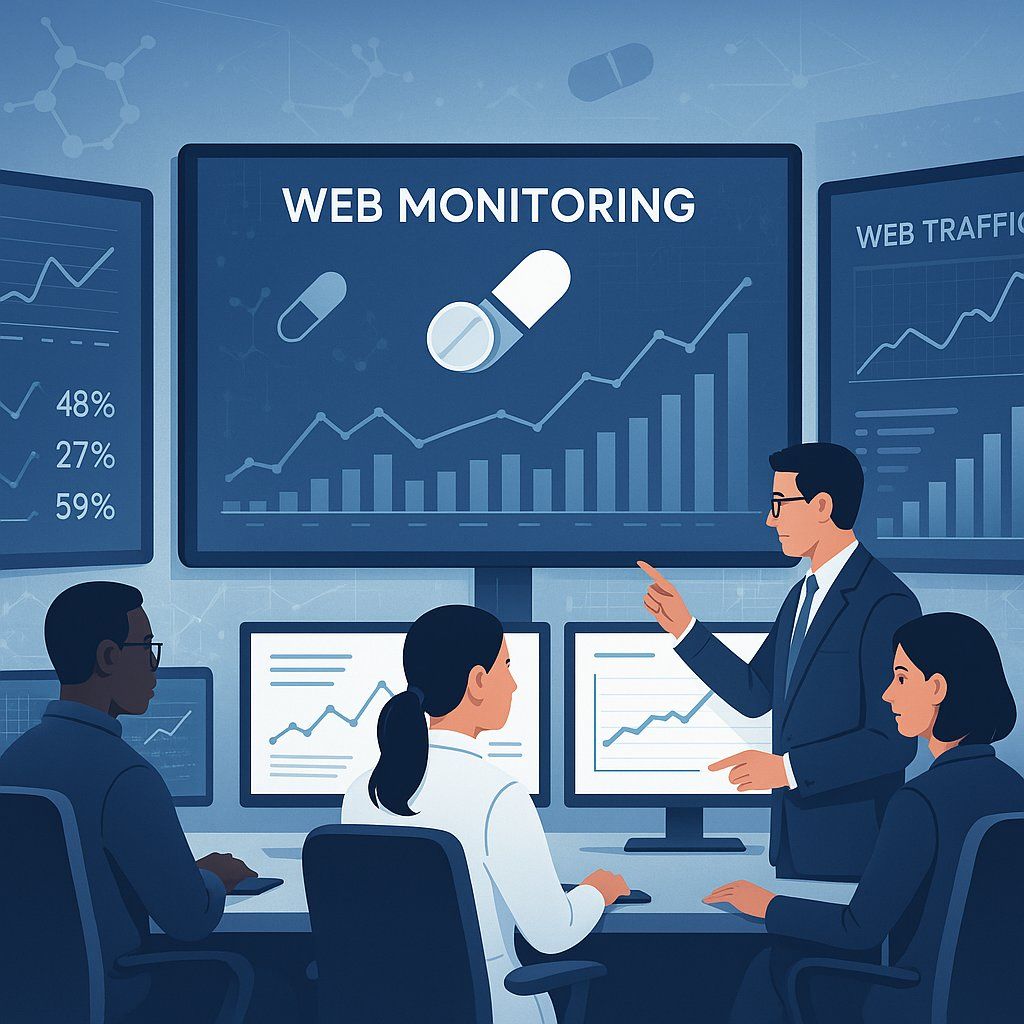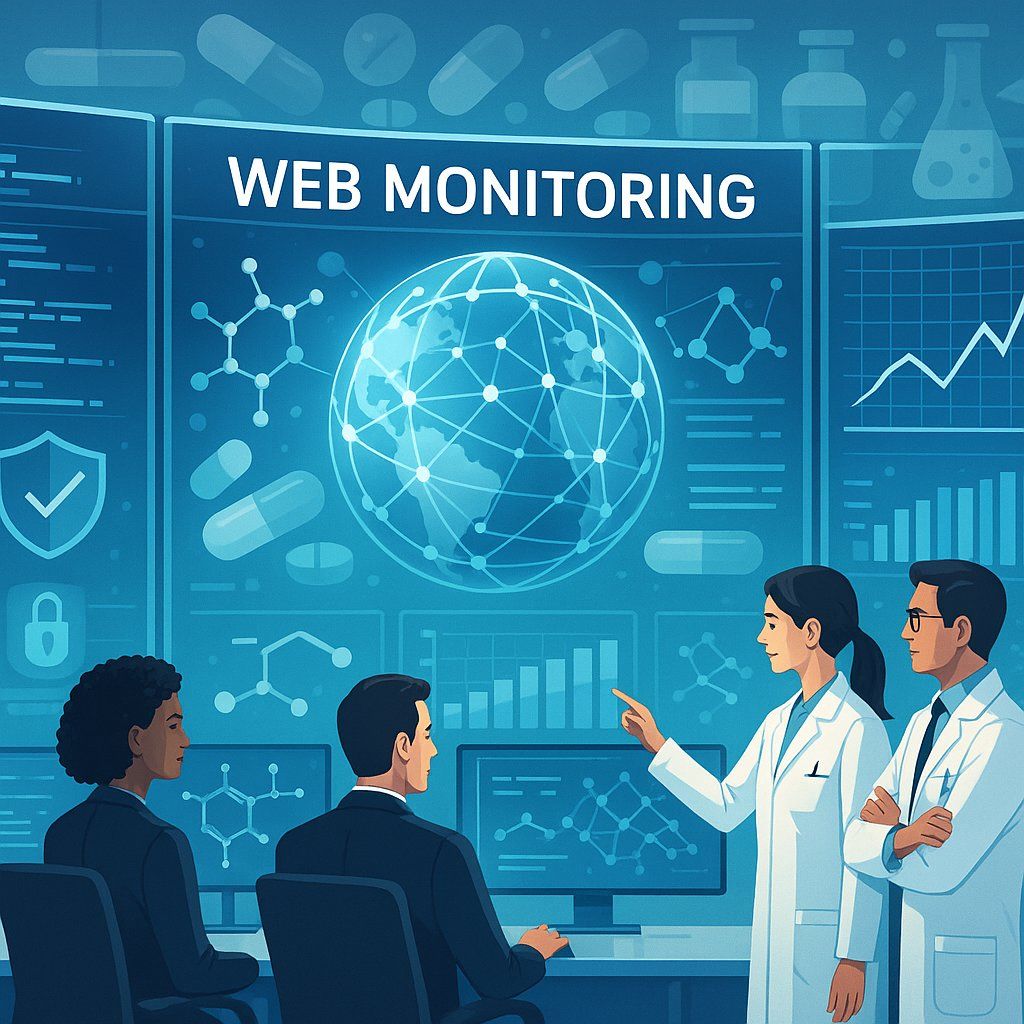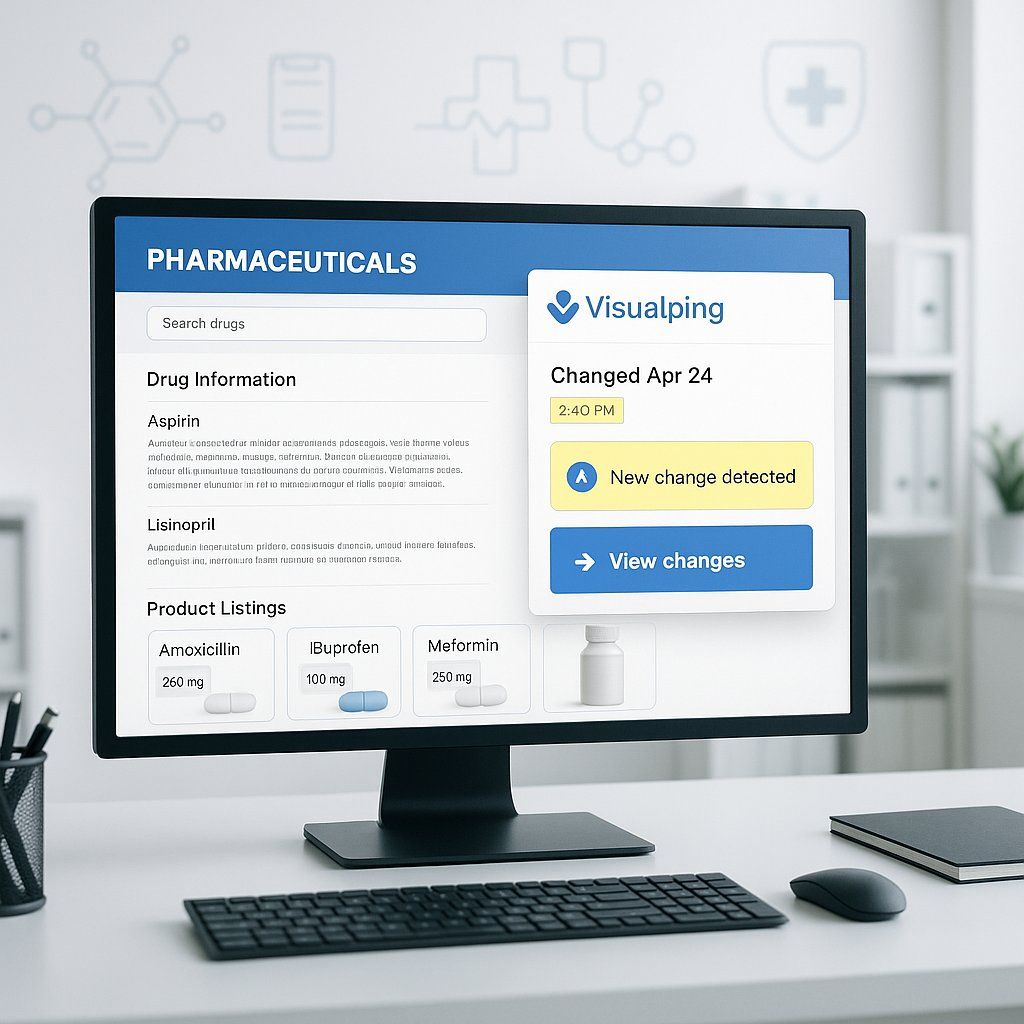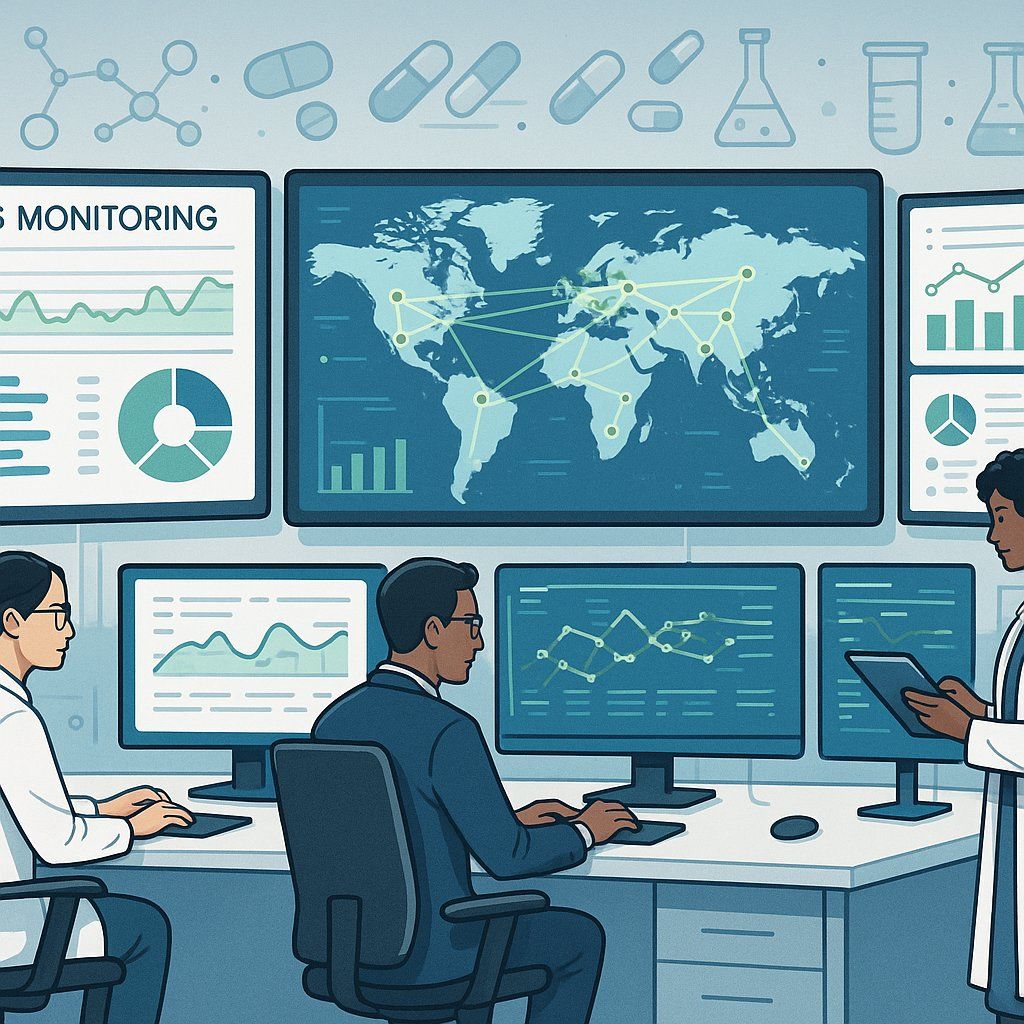How to Use Web Monitoring for Pharma Market Insights: Leverage Visualping
By Eric Do Couto
Updated July 7, 2025

How to Use Web Monitoring for Pharma Market Insights: Leverage Visualping
The pharmaceutical industry moves at lightning speed, with drug approvals, clinical trial results, and regulatory changes happening constantly across multiple websites and databases. Web monitoring tools like Visualping allow pharmaceutical professionals to automatically track these critical updates across competitor pipelines, regulatory agencies, and market intelligence sources without manual checking. This automated approach transforms how companies gather market insights and make strategic decisions.
Traditional methods of tracking pharmaceutical market changes involve manual website visits, spreadsheet updates, and delayed information gathering. Visualping offers a web monitoring solution that sends instant alerts when specific pages change, helping professionals stay ahead of market developments. The tool monitors everything from FDA approval announcements to competitor pipeline updates.
Pharmaceutical companies need real-time intelligence to make informed decisions about drug development, investment strategies, and competitive positioning. This article explores how web monitoring technology can streamline market intelligence workflows, ensure regulatory compliance, and provide the competitive edge needed in today's pharmaceutical landscape.
Key Takeaways
- Web monitoring automates the tracking of pharmaceutical market changes across multiple websites and regulatory sources
- Visualping provides customizable alerts and AI-powered analysis specifically designed for pharma industry professionals
- Automated monitoring ensures regulatory compliance while optimizing market intelligence workflows for better decision-making
How to Set Up Monitoring of Pharmaceutical Websites with Visualping
Step 1: Create Your Visualping Account
- Navigate to visualping.io and click "Get Started Free" to begin. Business users will get access to the full suite of Visualping tools, while users registering with free email accounts will get access to the basic set of features
- Enter your email address and create a strong password
- Verify your email through the confirmation link sent to your inbox
- Complete your profile with your organization name and monitoring goals
- [Optional]: Upgrade to a paid plan by clicking "Upgrade" in your dashboard
- For pharmaceutical monitoring, it's recommended to select at minimum the Business plan ($100/month). This provides 20,000 checks, 500 pages, and crucial AI features
Step 2: Configure Your Workspace
Set up your workspace for pharmaceutical monitoring:
- Name your workspace (e.g., "Regulatory Monitoring" or "Pharma Intelligence")
- Invite team members who need access to monitoring alerts
- Set workspace permissions to control who can create or modify monitors
Step 3: Monitor FDA Drug Approvals
Let's start with a critical example: monitoring FDA's drug approval database.
- Navigate to the FDA approvals page: https://www.fda.gov/drugs/drug-approvals-and-databases
- Click the Visualping extension or use "New Job" in your dashboard
Configure basic settings:
- Name the Job: "FDA Drug Approvals - [Therapeutic Area]"
- URL: Confirm the correct page is selected
- Monitoring Type: The job will default to 'Visual' which will work really well here!
Step 4: Select Monitoring Area
Instead of monitoring the entire page (which includes navigation and footers), focus on relevant content:
- Click "Select Area" in the monitor setup
- Draw a rectangle around the main content area containing approval listings
- Preview your selection to ensure you've captured the right content
Step 5: Configure your alerts with AI
The Visualping's Important Alerts feature is crucial for pharmaceutical monitoring. This allows you to get a detailed contextual summary of what's changed on the page, and also allows you to only get alerted when relevant changes happen.
Here's how to configure it:
- In the AI Summaries box, enter your prompt or 'important filter'
Try something like:
Monitor this page for:
- New drug approvals or NDAs in [my therapeutic area]
- Changes to approval status
- Safety updates or warnings for [my products]
- Regulatory guideline updates
Optional: You can also turn on the 'Alert me only when this condition is met' filter; this means you'll only receive alerts when a change that matches your important filter occurs.
Step 6: Configure your notifications
Select whether you want to receive alerts for changes to this page via Email, Slack, Teams, Webhooks, Discord, Google Sheets, or other methods.
Understanding Web Monitoring for Pharma Market Insights
Web monitoring transforms how pharmaceutical companies gather market intelligence by tracking competitor activities, regulatory changes, and industry trends across digital platforms. Companies can make faster strategic decisions when they have access to real-time data and automated alerts about market developments.
The Importance of Market Intelligence in Pharma
Market intelligence serves as the foundation for strategic decision-making in pharmaceutical companies. It provides critical insights into competitor pipelines, regulatory developments, and emerging market opportunities.
AI-powered market intelligence tools in pharma help companies analyze regulatory changes and identify risks such as safety concerns or competitive threats. These tools enable proactive measures rather than reactive responses.
Pharmaceutical companies use market intelligence to track key performance indicators (KPIs) like market share growth, R&D spending, and drug approval rates. These metrics help companies benchmark their performance against competitors.
Essential KPIs for pharma market intelligence include:
- Clinical trial success rates
- Time-to-market for new drugs
- Regulatory approval timelines
- Patent expiration dates
- Market share by therapeutic area
Companies that integrate market intelligence effectively gain significant advantages. They achieve faster market entry and improved regulatory compliance compared to competitors who rely on traditional research methods.
Key Challenges in Gathering Web Data
Pharmaceutical companies face unique obstacles when collecting web-based market data. The industry's highly regulated nature creates complex compliance requirements for data collection and analysis.
Data volume and complexity present major challenges for pharma insights teams. Pharmacovigilance tracking and reporting requires 100% compliance with evolving regulatory requirements across different regions.
Common web data collection challenges include:
- Scattered information across multiple regulatory websites
- Frequent updates to competitor websites and press releases
- Language barriers for global market monitoring
- Privacy regulations affecting data collection methods
Manual monitoring processes cannot keep pace with the speed of industry changes. Companies need automated solutions to track competitor activities, patent filings, and regulatory announcements efficiently.
Web scraping in pharmaceuticals requires specialized expertise to navigate complex websites and extract meaningful data. Pharmaceutical data extraction reveals competitor strategies and emerging market trends that manual research might miss.
Role of Real-Time Data in Decision-Making
Real-time data enables pharmaceutical companies to respond quickly to market changes and competitive threats. Companies can adjust their strategies immediately when new information becomes available.
Real-time HCP-patient insights are transforming pharma strategies by providing immediate feedback on treatment outcomes and physician preferences. This data shapes market positioning and product development decisions.
Drug development timelines benefit significantly from real-time monitoring. Companies can track competitor clinical trials, regulatory submissions, and market approvals as they happen.
Real-time data applications in pharma include:
- Monitoring FDA approval announcements
- Tracking competitor product launches
- Analyzing social media sentiment about treatments
- Observing pricing changes in key markets
Drug price monitoring and web scraping provide real-time pricing data and competitive insights that enhance market research capabilities. This information helps companies make informed pricing decisions quickly.
Companies use real-time alerts to stay informed about regulatory changes that could impact their operations. Immediate notifications allow teams to assess potential impacts and develop response strategies before competitors react.
Overview of Visualping for Pharma Professionals

Visualping serves as a comprehensive web monitoring solution that tracks pharmaceutical pipeline changes, regulatory updates, and competitor activities through automated alerts and AI-powered change detection. The platform offers specialized features for monitoring drug development websites while providing significant advantages over traditional manual tracking methods.
Core Features of Visualping
Visualping is a web monitoring tool that automates the tracking of changes on pharmaceutical websites. Users can monitor specific sections of web pages for updates to drug candidate status, trial results, or regulatory announcements.
The platform provides customizable monitoring frequencies ranging from every five minutes to once monthly. This flexibility allows pharmaceutical professionals to tailor their monitoring based on the urgency of different pipeline stages.
AI-powered change summaries help users quickly understand what has changed without reviewing entire web pages. The system can detect both visual and text modifications across monitored sites.
Email alerts deliver instant notifications when changes occur on tracked pages. Users can configure keyword-based alerts to receive notifications only when specific terms appear on monitored websites.
The Visualping button feature allows businesses to integrate monitoring capabilities directly into their webpages, so that visitors can get updated when news or updates are released; this helps bring back visitors to their website.
Visualping's Relevance to Pharmaceutical Markets
The pharmaceutical industry requires constant monitoring of pipeline developments due to the high stakes involved in drug development. Timely data becomes crucial for investment and pharma industry professionals who need to make strategic decisions based on current information.
Regulatory changes can significantly impact drug development timelines and market opportunities. Visualping enables professionals to track FDA announcements, clinical trial registrations, and regulatory filing updates across multiple sources simultaneously.
Competitor pipeline monitoring provides insights into market positioning and potential threats. Users can track competitor drug development progress, partnership announcements, and regulatory milestones.
The platform supports monitoring of various pharmaceutical data sources including company pipeline pages, clinical trial databases, and regulatory agency websites. This comprehensive coverage ensures professionals stay informed about all relevant market developments.
Benefits Over Manual Monitoring
Traditional manual tracking methods using spreadsheets are time-consuming and prone to errors. These approaches often result in missed critical updates that could impact investment or development decisions.
Real-time monitoring capabilities eliminate the lag associated with manual checking. Professionals receive immediate notifications when important changes occur, allowing for faster response times.
The automated system reduces human error and ensures consistent monitoring across multiple websites. Users no longer need to remember to check dozens of different pipeline pages manually.
Scalability represents a major advantage over manual methods. A single user can monitor hundreds of pharmaceutical websites simultaneously without increasing workload or staffing requirements.
Cost efficiency improves significantly as automated monitoring eliminates the need for dedicated personnel to manually track pipeline changes. The system operates continuously without requiring constant human supervision.
Detecting and Analyzing Website Changes

Website change detection tools automatically track updates across pharmaceutical websites and regulatory platforms. These systems capture visual differences and provide detailed comparisons to help teams identify critical information updates.
How Website Change Detection Works
Website monitoring tools scan web pages at set intervals to identify any modifications. The software takes screenshots of pages and compares them against previous versions to spot differences.
AI-powered monitoring platforms use advanced algorithms to detect text changes, visual updates, and HTML modifications. These tools can focus on specific page sections rather than monitoring entire websites.
Users receive instant alerts when changes occur. The notifications include details about what changed and when the update happened.
Key detection methods include:
- Visual comparison using screenshots
- Text content analysis
- HTML code monitoring
- Keyword-specific tracking
Modern tools filter out irrelevant changes like advertisements or timestamps. This prevents alert fatigue and ensures teams only receive notifications about meaningful updates.
Before-and-After Screenshot Comparison
Screenshot comparisons provide clear visual evidence of website changes. The side-by-side images highlight exactly what content was modified, added, or removed.
Visual change detection systems mark differences with colored highlights or overlays. This makes it easy to spot even small text changes or layout modifications.
The comparison feature works particularly well for:
- Regulatory announcements on government websites
- Drug approval status updates
- Clinical trial result publications
- Safety alert postings
Teams can review historical changes to track how information evolved over time. This creates a valuable record of regulatory developments and competitor activities.
Screenshot archives also serve as compliance documentation. Companies can prove they monitored required sources and responded to updates promptly.
Significance of Monitoring Regulatory Bodies like EMA
The European Medicines Agency (EMA) publishes critical drug safety information and regulatory decisions. These updates directly impact pharmaceutical companies' operations and market strategies.
EMA website changes often signal important developments. New drug approvals, safety warnings, and guideline updates appear on their platforms before other channels.
Critical EMA sections to monitor include:
- Medicine approval announcements
- Safety alert publications
- Clinical trial guidelines
- Market authorization decisions
Missing these updates can result in compliance violations or missed business opportunities. Automated monitoring ensures teams receive immediate notifications about relevant changes.
The EMA updates multiple pages simultaneously during major announcements. Manual checking would require significant time and resources while risking oversight of important information.
Customizing Visualping for Pharma Use Cases

Pharmaceutical professionals can maximize Visualping's effectiveness by adjusting alert frequencies, selecting relevant metrics, and focusing on competitor pipeline activities. These customizations ensure teams receive actionable insights without information overload.
Tailoring Alert Settings and Monitoring Frequency
Pharmaceutical companies need different monitoring speeds based on their specific goals. Clinical trial updates require frequent checks, while regulatory approvals need less frequent monitoring.
High-Priority Monitoring (Every 5-15 minutes):
- FDA approval announcements
- Clinical trial results
- Safety alerts and recalls
Medium-Priority Monitoring (Daily):
- Patent filings
- Partnership announcements
- Market research reports
Low-Priority Monitoring (Weekly):
- General company news
- Industry conference updates
- Quarterly earnings reports
Teams can customize settings to match their workflow needs. Alert fatigue becomes a real problem when monitoring frequencies are too high for routine updates.
Users should test different frequencies first. Start with daily monitoring and adjust based on the volume of changes detected.
Selecting Key Performance Indicators to Track
Effective pharma monitoring focuses on specific KPIs that drive business decisions. Generic monitoring wastes time and resources.
Pipeline KPIs to Monitor:
- Trial Phase Progressions: Movement from Phase I to Phase II or III
- Enrollment Numbers: Patient recruitment rates and completion percentages
- Regulatory Milestones: FDA fast-track designations and breakthrough therapy status
- Safety Data: Adverse event reports and trial suspensions
Market KPIs to Track:
- Competitor Launch Dates: New drug approvals and market entry timing
- Pricing Changes: List prices and discount programs
- Market Share Shifts: Prescription data and sales figures
Teams should limit monitoring to 5-7 key performance indicators per product. Too many metrics create noise and reduce focus on critical changes.
Utilizing Visualping for Competitor Monitoring
Competitor monitoring helps pharma companies anticipate market changes and adjust strategies accordingly. Strategic intelligence requires focused tracking of specific competitor activities.
Essential Competitor Pages to Monitor:
- Pipeline pages showing drug development status
- Press release sections for partnership announcements
- Clinical trial databases for new study initiations
- Patent databases for intellectual property filings
Monitoring Strategy: Companies should track 3-5 direct competitors rather than monitoring entire industries. Focus on competitors with overlapping therapeutic areas or similar target markets.
Set up separate monitoring for different competitor activities. Use keyword alerts to catch mentions of specific drug names or therapeutic areas.
Track competitor clinical trial pages for enrollment updates and timeline changes. These insights help predict when competitive products might reach market.
Ensuring Regulatory Compliance Through Automated Monitoring

Pharmaceutical companies must track constant regulatory changes and maintain detailed audit trails to meet compliance requirements. Automated monitoring systems provide real-time alerts for regulatory updates while creating secure documentation trails that satisfy audit demands.
Tracking Regulatory Updates and Announcements
Regulatory monitoring systems automatically track changes across multiple government websites and regulatory bodies. These tools eliminate manual checking by scanning FDA announcements, EMA updates, and local regulatory authority publications continuously.
Companies can set up keyword-based alerts to filter relevant changes. For example, alerts can trigger when specific drug classifications or therapeutic areas appear in new guidance documents.
Key monitoring targets include:
- FDA guidance documents
- Drug approval announcements
- Warning letters and enforcement actions
- Policy changes and draft regulations
- International regulatory updates
AI-powered compliance monitoring enhances accuracy by summarizing complex regulatory changes into actionable insights. These systems identify which updates require immediate attention versus those for future planning.
Automated systems can monitor pages as frequently as every five minutes for critical updates. Less urgent regulations can be tracked daily or weekly depending on business needs.
Audit Trails and Data Security Considerations
Automated compliance systems create comprehensive audit trails that document when regulatory changes were detected and how companies responded. These records prove compliance efforts during regulatory inspections.
Essential audit trail components:
- Timestamp of regulatory change detection
- Screenshot evidence of original and updated content
- Distribution records showing who received alerts
- Response documentation and action taken
Data security becomes critical when monitoring sensitive regulatory information. Enterprise-grade systems offer encrypted data transmission and secure server storage with 99% uptime guarantees.
Companies must ensure monitoring tools comply with data protection regulations in their operating jurisdictions. Access controls limit who can view sensitive regulatory intelligence and modify monitoring parameters.
Regular backup systems protect against data loss while maintaining historical records of regulatory changes. This documentation supports long-term compliance strategies and regulatory submission requirements.
Optimizing Market Intelligence Workflows with Visualping
Teams can streamline their pharmaceutical market intelligence operations by organizing collaborative monitoring systems, building comprehensive data dashboards, and establishing automated reporting processes. These workflow optimizations enable faster decision-making and more accurate market analysis.
Organizing and Collaborating with Teams
Pharmaceutical companies need structured approaches to share market intelligence across departments. Teams should establish clear ownership of different monitoring targets to avoid duplication and ensure comprehensive coverage.
Visualping's collaborative features allow multiple team members to access shared monitoring projects. Research teams can track competitor pipelines while regulatory affairs monitors approval timelines simultaneously.
Key organizational strategies include:
- Assigning specific therapeutic areas to individual team members
- Creating shared monitoring folders for cross-functional projects
- Setting up role-based access controls for sensitive competitive data
- Establishing escalation protocols for urgent market changes
Teams benefit from regular review meetings to discuss monitored changes and their implications. This collaborative approach ensures that real-time data reaches the right stakeholders quickly.
Documentation standards help maintain consistency across team members. Each monitored page should include clear descriptions of what changes trigger alerts and who receives notifications.
Integrating Visualizations and Dashboards
Market intelligence teams require centralized views of their monitoring activities and results. Dashboard integration transforms scattered alerts into actionable insights that support strategic planning.
Teams can connect Visualping alerts with business intelligence platforms to create comprehensive market views. This integration allows pharmaceutical companies to correlate website changes with other market indicators.
Effective dashboard elements include:
- Competitor activity timelines showing recent changes
- Pipeline progression tracking across multiple companies
- Regulatory milestone calendars with automated updates
- Market trend visualizations combining multiple data sources
Visual representations help teams identify patterns in competitor behavior and market movements. Charts showing frequency of competitor updates can reveal strategic timing insights.
Key performance indicators should track both monitoring effectiveness and business impact. Metrics like alert accuracy rates and decision response times help optimize the monitoring system.
Setting Up Effective Reporting
Automated reporting systems ensure that market intelligence insights reach decision-makers consistently. Teams should establish regular reporting schedules that align with business planning cycles.
Pharmaceutical pipeline monitoring generates large volumes of data that require structured reporting approaches. Weekly summaries can highlight significant changes while monthly reports provide strategic context.
Essential reporting components include:
- Executive summaries highlighting critical market developments
- Detailed change logs for compliance and audit purposes
- Trend analysis comparing current activity to historical patterns
- Action item recommendations based on detected changes
Reports should segment information by audience needs. Senior executives require high-level strategic insights while research teams need detailed technical information.
Customizable report templates ensure consistency across different therapeutic areas and business units. Templates should include standard sections for market changes, competitive implications, and recommended actions.
Frequently Asked Questions
Pharmaceutical professionals need specific features and capabilities when selecting web monitoring tools for market research. Cost considerations, integration options, and competitive advantages play key roles in choosing the right solution for tracking drug pipeline changes and market developments.
What features should I look for in a pharma market insight web monitoring tool?
Essential features include real-time alerts for pipeline changes and regulatory updates. The tool should offer customizable monitoring frequency from every five minutes to monthly checks.
AI-powered change summaries help professionals quickly understand important updates. Advanced keyword detection ensures users receive alerts only for relevant pharmaceutical developments.
Email notifications remain standard, but SMS and API integration provide additional alert options. The ability to monitor specific webpage sections rather than entire pages reduces false positives.
How can web monitoring tools like Visualping provide competitive advantage in the pharmaceutical industry?
Visualping enables pharmaceutical professionals to track competitor drug pipelines and receive instant notifications when changes occur. This real-time information allows for quick strategic decisions in a fast-moving industry.
Companies can monitor regulatory approvals, trial results, and partnership announcements from competitors. Early detection of these changes helps businesses adjust their own strategies and investment decisions.
The tool eliminates manual tracking methods that often miss critical updates. Automated monitoring ensures no important pharmaceutical developments go unnoticed.
What are the costs associated with premium web monitoring services, and how do they compare with free versions?
Free versions typically offer basic monitoring capabilities with limited frequency checks. Premium services provide more frequent monitoring intervals and advanced features like AI summaries.
Paid plans usually include multiple notification methods and integration with third-party applications. The exact pricing varies by provider and depends on monitoring frequency and feature requirements.
Professional pharmaceutical users often need premium features for comprehensive market tracking. The investment typically pays for itself through improved decision-making capabilities.
How does website change detection technology benefit pharmaceutical market research?
Change detection technology automatically tracks updates across multiple pharmaceutical websites simultaneously. This eliminates the time-consuming process of manually checking pipeline pages and regulatory sites.
The technology provides historical change tracking to identify patterns in drug development timelines. Researchers can analyze competitor behavior and market trends over time.
Instant notifications ensure market researchers never miss critical regulatory approvals or pipeline updates. This speed advantage proves crucial in pharmaceutical investment and strategic planning.
What are some popular alternatives to Visualping for monitoring changes on pharma industry websites?
ChangeTower and Changedetection offer less comprehensive web monitoring capabilities for pharmaceutical professionals. These tools provide automated change detection and notification services but lack the precision, AI summaries, and Important Alert filtering that Visualping offers.
Each alternative offers different pricing structures and feature sets. Some focus on specific industries while others provide general web monitoring capabilities.
The choice depends on specific pharmaceutical monitoring needs and budget requirements. Features like API integration and custom alerts vary between different platforms.
Can web monitoring tools integrate with other software to enhance market data analysis for the pharmaceutical sector?
Visualping's web monitoring tools offer API integration capabilities for connecting with existing pharmaceutical research systems. This allows automatic data flow into analysis platforms and databases.
Integration with CRM systems helps pharmaceutical companies track competitor activities alongside their own sales data. Slack and email integrations such as those offered by Visualping ensure relevant team members receive critical updates immediately.
Some tools connect with business intelligence platforms to combine web monitoring data with other market research sources. This creates comprehensive pharmaceutical market analysis dashboards.
Boost your pharmaceutical intelligence team with Visualping
Sign up now to receive instant, AI-powered alerts on critical pharmaceutical market updates—empower your team with timely insights and smarter decisions.
Eric Do Couto
Eric is the Senior Partnerships Manager at Visualping. Eric has over 10+ years of experience in Marketing and Growth Leadership roles across various industries. His experience with website archiving and screenshot archiving has been to gather competitive intelligence for various go-to-market teams.